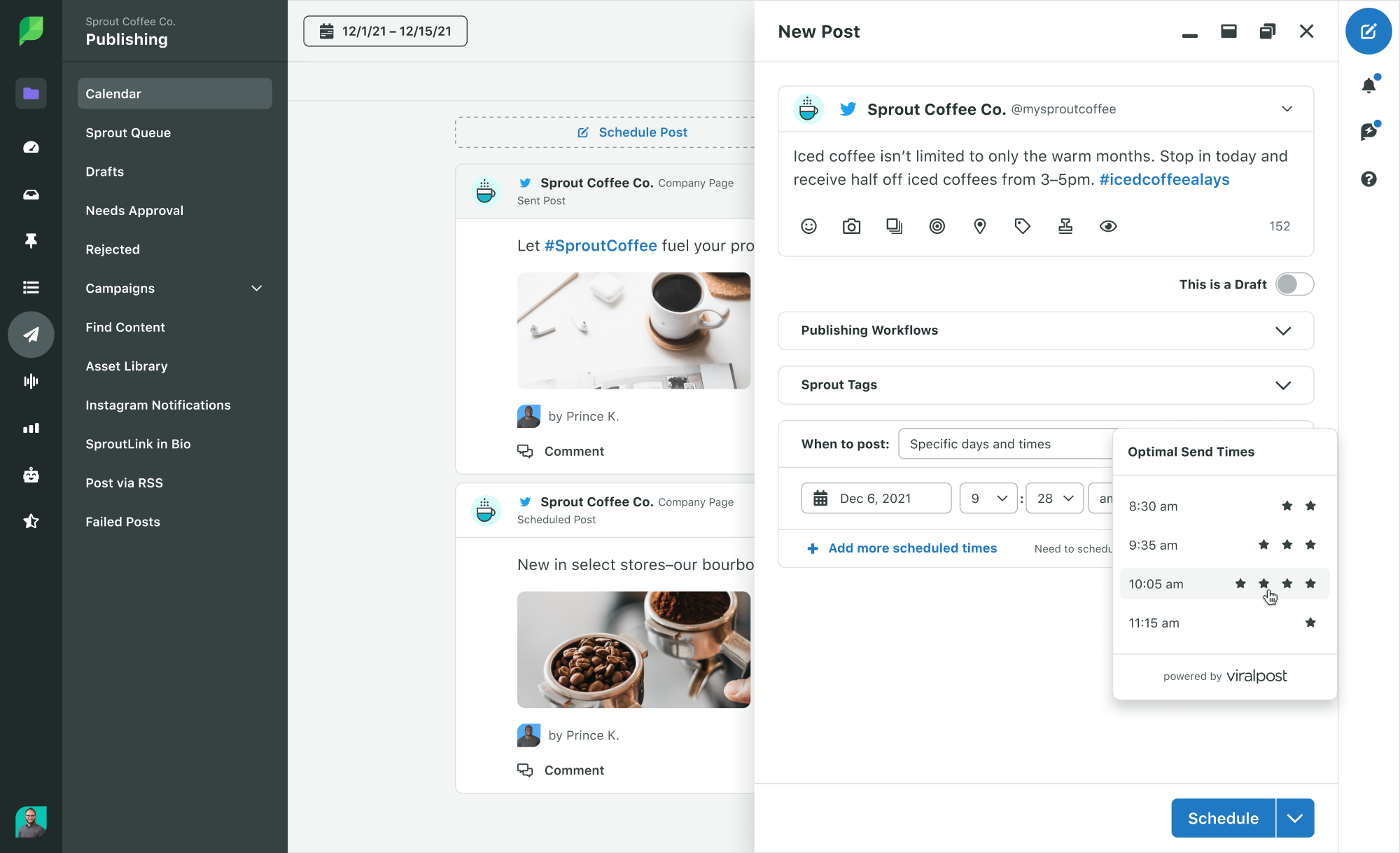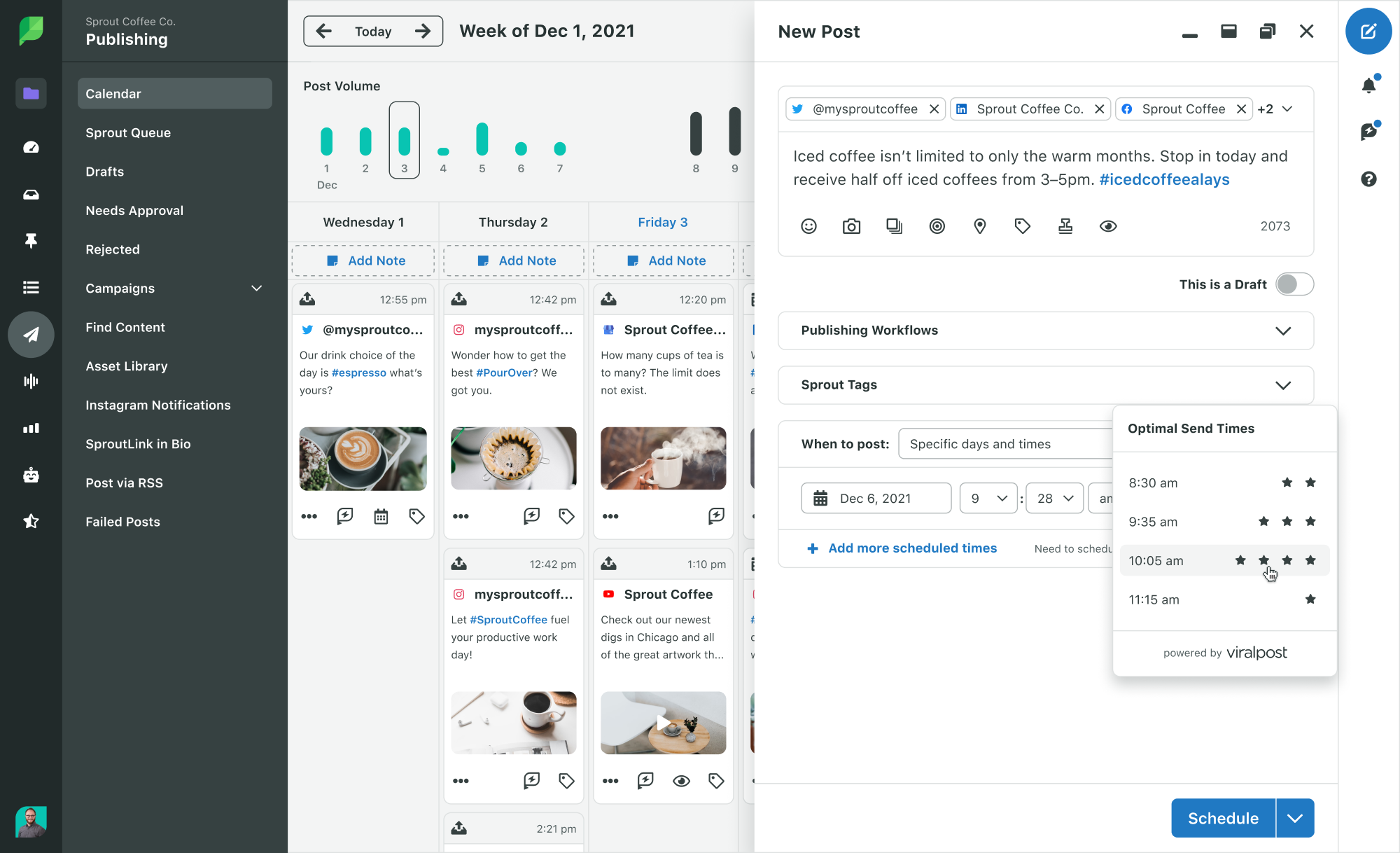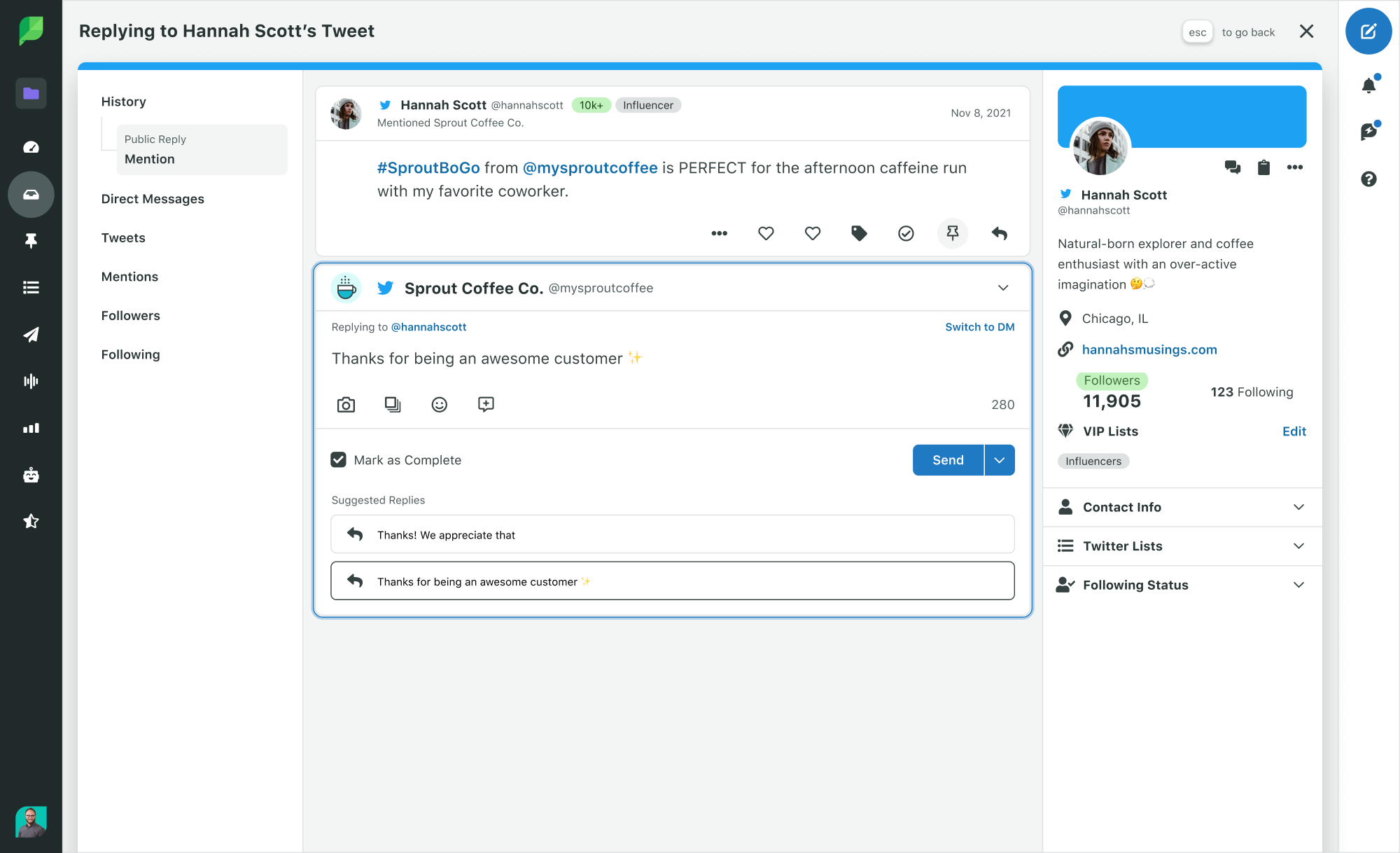How to create a Twitter marketing strategy for your brand
Twitter started out as a place for people to share their every thought. Now it’s turned into a powerful marketing platform that lets brands connect with their audience. Boasting 217 million monetizable users per day, it’s easy to see why companies keep using Twitter after all of this time. But it’s no longer enough to send out the occasional Tweet about a trending topic. Brands need to be more intentional with their Twitter marketing so they can stand out and keep their audience engaged.
That’s exactly what we’ll discuss in this guide. Let’s take a look at the step-by-step process of creating a Twitter marketing strategy to grow your presence and drive engagement.
Table of Contents
- What is Twitter marketing?
- Audit your Twitter account
- Find your Twitter voice
- Use Twitter hashtags and trends
- Utilize Twitter ads
- Find out when to Tweet
- Schedule Tweets ahead of time
- Engage with your Twitter followers
- Set measurable Twitter goals
- Unleash the power of Twitter marketing
What is Twitter marketing?
Twitter marketing is the process of promoting your brand and its products or services through Twitter. It involves a well-established social media marketing strategy to create and publish content on the platform. When you market on Twitter, you need to publish the right Tweets at the right time to attract the right audience.
It doesn’t stop with posting content. Twitter marketing requires a plan to engage and interact with your audience. Twitter is a conversation-based network, so it’s important to create a two-way conversation with followers by replying to Tweets or direct messages.
Some Twitter marketing strategies may include a plan to advertise on the platform. This involves delivering targeted ads or promoted Tweets to a relevant audience. We’ll get into the details later in this guide.
However you approach Twitter marketing, make sure your strategy is aligned with your business goals and the style of the network. With that said, use these 9 tips to guide you through your Twitter marketing strategy:
1. Audit your Twitter account
If you already have an existing Twitter profile, the first thing to do is to run a Twitter audit.
Take stock of what’s working and what isn’t working by doing an in-depth review of your Twitter analytics. Twitter analytics tools help by allowing you to analyze:
- Hashtag performance
- Individual Tweet performance
- Individual Twitter audience
Knowing which Tweets are performing the best will give you an idea of the type of content that your audience is most interested in seeing. You can use this information to create a strategy to give your audience what they’re looking for in your content. This will ultimately allow you to maximize the reach and engagement you get on your Tweets.
One way to audit your Twitter profile is to look over your analytics manually from your Twitter Analytics dashboard. Here’s the step-by-step process to access this dashboard:
- When you’re logged in, click on the “More” button from the left-hand panel of your Twitter dashboard.
- Expand the “Creator Studio” option and select “Analytics.” This will open the Twitter Analytics dashboard.
- From here, find “Tweet Highlights” and select “View all Tweet activity”. This will open a graph of all the impressions you earned for your Tweets within any given time period.
- Below the graph, you can see the impressions, engagements and engagement rates for each Tweet. Click on “Top Tweets” to see your best-performing Tweets. Check out the performance of your promoted Tweets by clicking on the “Promoted” tab.

If you’re using Sprout Social to manage your Twitter profile, you can access your Twitter analytics alongside your other social media data in the Cross-Network Post Performance Report. Find your impressions, potential reach, engagements, engagement rate per impression to each of your Tweets.

2. Find your Twitter voice
Audiences on Twitter are looking for brands that Tweet authentically and stay true to their voice. It can be easy to jump on the latest trends to appeal to the masses on Twitter. But don’t do this at the expense of losing your brand voice. Your Twitter presence can be more playful and casual than LinkedIn or Facebook. However, it should still be authentic and consistent with your brand voice as a whole.
Innocent Drinks has nailed its brand voice on Twitter. Going through the brand’s feed, you can immediately see the brand’s persona shine through. The brand voice is fun, friendly, honest and approachable. It sometimes comes across as somewhat naïve, or you could say “innocent”–just like the brand.
Our boss came in with this mug today. We just want you to know that we did not buy it for him. pic.twitter.com/2n31BY5I6l
— innocent drinks (@innocent) November 9, 2022
Remember, an engaging brand voice is essential, but don’t jump on trends just for the sake of staying relevant. Twitter users are especially astute when a brand is inauthentic in an attempt to generate attention. In other words, don’t try too hard to fit in and instead, stay true to your brand.
3. Use Twitter hashtags and trends
Hashtags are a great way to expose your brand to new audiences who may be interested in what you have to say. They’re particularly effective for connecting your brand with what’s happening on Twitter. In fact, hashtags can increase message association by 18% and brand awareness by 8%. What’s more, is that brands saw a 3% lift in purchase intent by using hashtags to connect their brand with what’s happening on Twitter.
Some brands create hashtags for a specific campaign and use them in relevant Tweets. They may even encourage their audience to share Tweets with that hashtag.
One excellent example is the #RebuildTheWorld hashtag campaign from LEGO. LEGO used the campaign to inspire people to unleash their creativity. Additionally, it helped to showcase the virtually endless possibilities that LEGO play offers.
Within the first four days of launching the campaign, there were nearly 100,000 posts using the hashtag. Not only that but there was a 35% lift in positive sentiment for LEGO-branded keywords. First launched in 2019, the #RebuildTheWorld campaign is now an annual event.
What’s part spaceship, part castle and part… giraffe?! Only the best gift-giving vehicle you’ve ever seen! Fire up your imagination and join Katy Perry (and her little LEGO helpers) on a mission to build our most playful holiday ever!
#RebuildTheWorld pic.twitter.com/n8lOfBCAws
— LEGO (@LEGO_Group) November 1, 2022
Utilize Sprout’s Trend Reports
Can’t think of what to post or which hashtags to use? Sprout’s Twitter Trends Report generates topics and hashtags that are trending with your audience in relation to your account or industry. This can give you an idea of what your audience is talking about, so you know how to get their attention.

4. Utilize Twitter ads
Using paid ads on Twitter is a great way to reach your audience in a more direct way than waiting for organic reach. Promoted Tweets can expand your reach more quickly.
They allow people to discover your profile, even if they don’t follow your brand or hashtags. When you use a promoted Tweet, your Tweets show up on the timelines of people who share interests with your audience.
You pay a monthly fee as long as you want the promoted Tweet to stay up. Users can interact with promoted Tweets in the same way they interact with organic content. The only difference is that promoted Tweets are labeled, so users transparently know it’s a paid ad.
Confluent uses Twitter advertising to promote its platform through a lead magnet–in this case, a free eBook. In the following promoted Tweet, the company encourages downloads by describing the benefits. Anyone who wants to download it will have to share some of their info, allowing the company to capture valuable leads.

5. Find out when to Tweet
At the same time, Twitter moves so fast that something you Tweeted 30 minutes ago may very well be invisible to your followers. This makes it crucial to post at a time when your followers are most likely to see and engage with your Tweet. This would allow the Twitter algorithm to prioritize your Tweets and display them to an even bigger audience.
Sprout’s study on the best time to post on Twitter revealed that 9 a.m. on Mondays, Tuesdays, Wednesdays, Fridays and Saturdays are the best time to post on Twitter. That’s not to say Thursdays and Sundays are not good days to post; engagements on those days are not as high relative to the other days of the week or are sporadic.
Sprout’s ViralPost™ feature looks at your audience’s activity and chooses the most optimal times for you to post depending on when your followers are most active.

6. Schedule Tweets ahead of time
The right Tweet posted at the right time has the potential to generate massive engagement and virality. But you can’t possibly wait for your audience to be active every time you send out a Tweet.
Intentionally scheduling your Tweets ahead of time to makes publishing more efficient.
Knowing the right time to Tweet makes scheduling a consistent flow of Tweets much more manageable. It’s important to be as consistent as possible on Twitter. Best practices recommend Tweeting at least once per day.
Some brands Tweet up to 15 times per day to stay in front of their audience. Best practices can differ across industries. It depends on your resources and social media strategy to determine how frequently you can create and publish new content on Twitter.
Use Sprout’s publishing tool to schedule your Tweets to go out at optimal send times. This allows you to schedule your Tweets for an entire week or month, making it easier to maintain consistency.

7. Engage with your Twitter followers
Twitter is all about creating a two-way channel of communication with your audience. It’s important to create content that encourages your audience to engage with your Tweets. A lot of businesses use Twitter as a way to field support questions.
Meanwhile, you need to make sure that you’re engaging with people who are Tweeting about your brand individually. If someone mentions your brand or responds to a Tweet, make sure you’re responding to their message in a timely fashion.
It’s a good idea to have a dedicated community manager handle these requests. This will help prevent responses from falling through the cracks.
At Sprout, we closely monitor any brand mentions and look for opportunities to engage. Whether it’s a question about student programs, a support-related problem or a positive mention, we make it a point to respond.
Hey, Michael! We just replied to your DM.
— Sprout Social (@SproutSocial) November 15, 2022
Another way to create engagement with your followers is to ask questions. You can do this by creating a survey on Twitter directly or just asking a question and Retweeting people’s responses.
ClearVoice regularly posts Twitter surveys to ask questions to its audience. These may be about their content preferences and strategies. This gives the brand valuable research information to understand its audience better.
If you had to choose, how do you prefer to consume content:
— ClearVoice (@ClearVoice) November 7, 2022
Try out Sprout’s Suggested Replies feature
Sprout’s Suggested Replies feature can help simplify the process of responding to your audience. It lets you create canned responses for commonly asked questions on social media. Team members can then edit these with a personal touch. These responses give the people managing the profile behind the scenes a simple way to handle any volume of inquiries they get on Twitter.

8. Set measurable Twitter goals
Your Twitter marketing strategy needs measurable goals that will keep your plan on track. Instead of publishing Tweets and hoping for the best, set goals and objectives for Twitter. These goals should help your business meet its overall marketing goals. Goals for Twitter can include:
- Building an engaged following to increase brand awareness
- Generating leads by directing traffic to an offer or email list
- Increasing traffic to your website by posting links to blog content
- Building brand loyalty by providing excellent customer service on Twitter
- Networking with influencers and industry thought leaders to create more connections
Once you’ve determined your Twitter goals, set aside time every month to measure those goals. Make sure you know which Twitter metrics to track depending on your goal. Then you can analyze what’s working with your strategy and what needs tweaking. It helps to use a social media management platform like Sprout to measure your activity and track your goal’s progress.
Unleash the power of Twitter marketing
A solid Twitter marketing strategy gives you leverage in a competitive market. It helps you stand apart from the crowd while keeping your audience engaged. More importantly, it enables you to stay top of mind for your audience.
Use the steps outlined above to get started with Twitter marketing. And make sure to invest in a robust social media management platform like Sprout to make your job more efficient. Request a personalized demo to see how Sprout can help.
The post How to create a Twitter marketing strategy for your brand appeared first on Sprout Social.






